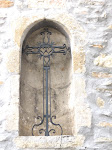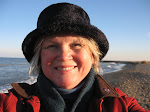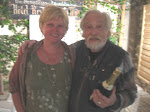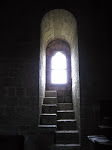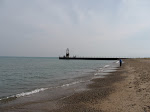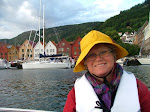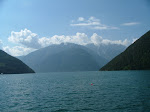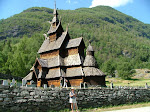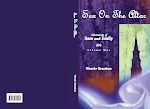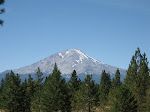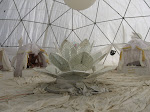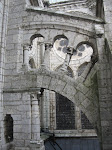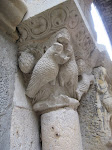On Wednesday September 18th, I will be interviewed by Karen Tate on her radio show "Voices of the Sacred Feminine". I am honored to be invited to speak on her show about the research I've done to write the historical novel about Mary Magdalene and her life; "Rituals in Sacred Stone".
These are the talking points I plan to discuss with her.
1) Religion today is totally different from religion in the time of Jesus and Mary Magdalene. We consider sitting in a church on Sunday being religious, whereas in their time they lived their religion. It was alive in the legends of the Gods enacted at the festivals honoring the year. It was understood as a relationship of abilities and forces inside every person developing as they evolved in their own lives.
2) Yeshua and Mariam lived at the tipping point of a paradigm shift, just like we do today. She represented the Goddess religions of Egypt and Mesopotamia, where the old mystery schools functioned. He represented the new idea of LOVE being the new focus of religious understanding. Together they faced the old patriarchy of the Jewish traditions and of Rome.
3) Unfortunately, the Roman Empire adopted the Christian movement, adapted it to fit over the existing Mithras religion, and organized it into a Holy Roman Empire, complete with an army, vast landmasses and the same rights as kings. Religion was used to keep the people they conquered at a low developmental level, creating good sheep, to enable them to collect wealth and power. They quite effectively taught shame and guilt instead of enlightenment, and have continued to do so for two thousand years.
4) Mariam was most likely betrothed to Yeshua from birth. They represent two different tribes of the Jewish people. She, from the Benjamin tribe, him from Joseph. The Benjamin tribe had responsibility for the land the Temple stood on, and the physical temple. His tribe was responsible for the functions in the temple. Together they represented the return of the original Jewish people to claim the temple in Jerusalem. The temple had just been rebuilt by Herod the Great, but the rabbis were friendly with the Romans. A change was needed to bring it back to it's old knowledge and glory.
5) Yeshua and Mariam were well educated. She was a priestess of the old mystery schools, he was trained in the ancient temple traditions, from before the first destruction by Babylonia in about 800 BC. A secret temple existed in the desert north of Heliopolis where they kept the old knowledge. These two were not "priest and priestess" they way we think of today. They were spiritual technicians who knew how to work with unseen forces. They were experts on the laws of physics that governs the spiritual worlds. They used them and they taught them. As for her being accused of being a prostitute; let's expand the story. She comes from a tradition where the sexual act is seen as a fertility rite done in public at the solstices. Seen from a patriarchal society, everything she represents then becomes improper, immoral, disgusting and barbaric. It is very likely people like Peter, a staunch traditionalist, would give her that epitaph without understanding the profound meaning behind her culture.
6) In the Biblical text, Mary Magdalene shows up whenever there is need for a ritual. She washes his feet, she anoints his head, and she follow him through his passion and shows up at Gethsemane Garden as he awakens. Or as in my story; she stayed with him in the tomb administering to him, bringing him back from his journey. She must have been a priestess and his wife. Only a wife was allowed to handle her husbands dead body, and only a priestess could perform the rituals.
7) Much points to that they were giving initiations to their inner circle of disciples. The story of Lazarus is similar to an Egyptian tradition, an initiation called The Journey of Osiris. Administered by trained priests and priestesses, the initiate would be given anointments and herbs and placed in a safe solitary place and then leave the body, appear dead, be gone for three days and then return to their body. Shakespeare described this as Juliet's experience. In the Bible, Lazarus is sent on a similar journey. The passion of Christ seems to follow the same pattern, but including the treatment of the Romans. The question then becomes; did they plan for that outcome? Did they know what the Romans would do to a rebel, and planned their own pageantry around it? It would fit very well in the mythology of their time. There were numerous stories of the sacrificed king, giving his life for the good of his people. These stories were played in front of people at the festivals. Yeshua living it for real made him even more believable.
8) Seen from the Roman's side, the only thing worse than a hero is a dead hero, and this one didn't even die properly, but resurrected himself. This was a total blow to the Roman authority. They were made into fools in front of the unruly people of Jerusalem, who didn't behave at all like other people they had taken over and absorbed. The people of Judea rebelled. In 70AD, shortly after the story of Christ, Jerusalem was destroyed. The famous temple was leveled and people massacred. Another diaspora occurred. The Judaic people were again spread all over the world.
9) Mary Magdalene, Jesus and their families had to escape immediately after the crucifixion. Their lives were in danger. The Romans didn't want any offspring from this famous rebel, and the rabbis weren't too happy with them either since they disturbed the working relationship they had with the Roman authorities. There are legends of Jesus in India and of Mary Magdalene in France. We know of the travel routes of Joseph of Aramathea between Jerusalem and Cornwall, England, passing through the Languedoc area of France. There are also legends in England about the early church, the first altar made by Jesus and his father, the first church built by Joseph of Arimathea and the stories of the hides of land in Glastonbury given as a gift to the family by king Arviragus. They were recognized as royal and treated accordingly.
10) The body of knowledge taught by Mary Magdalene in France was perpetuated by the Cathars and the Merovingian kings. In England, it became the Celtic church, which later had its seat in Ireland, perpetuating the teachings of personal enlightenment. They were famous for keeping the wisdom, writing copies of old scriptures and building monasteries, the universities of their time. As the Celtic church was building in Ireland, and started establishing monasteries and learning centers in Germany and France; the Catholic Church was building their influence from Rome and heading north. You now had two different belief systems building up to a clash of dimensions. The clash came with Charlemagne, who continued conquering northward, while the Celtic church aligned themselves with the Vikings as their armed warriors. This is the focus of my next book; "Secrets in Sacred Stone".
11) We are now at a time when the wisdom of old is being reawakened. The teachings of Mary Magdalene are hidden in forgotten parchments and symbols in stained glass windows. The way to find her is to go within and find where your body resonates with her. Enlightenment is a very physical endeavor. It is a question of establishing more light inside your body. This very refined process is what she taught. It is coming back. In the media of our time, we are finding her everywhere. Thanks to this radioshow, and other similar work all aimed at healing this emptiness, she is returning in our awareness. We are again realizing that we can build our own inner light, and we are starting to figure out how. Lennon said it best; Love is the answer.
I look forward to talking with Karen tomorrow. Please join me at 8pm Central time or hear the interview from the archives later.
Wencke.
Tuesday, September 17, 2013
Monday, September 16, 2013
I just listened to an interview by Karen Tate on her radio show "Voices of the Sacred Feminine" where she talked with an anthropologist from Italy who guides spiritual tours with Mary Magdalene as their focus. It was interesting to hear her speak from an academic view point and then describe the very emotional responses of her pilgrims.
I've been a pilgrim visiting the site they described. As I traveled alone in France, I went to the cave she described in the mountains near St.Baume. Karen asked about why the pilgrims were perturbed, but there wasn't enough time to go into the details. Well, I remember it well.
I came there on my research journey for "Rituals in Sacred Stone", and visited the cave after I had just been to the cathedral where her skull is displayed and had a profound experience there. My head was full of wonder over what I had seen and I felt her spirit very close, so I wanted to visit the cave as well and be further inspired. I was quickly shocked out of my reveries.
The landscape I arrived at was lovely with rolling hills and meadows, and surrounded with steep mountainsides, not too tall. You can see some buildings hanging onto the mountain and there is a well tended path to walk. As I walked the path, still in wonder of what I'd experienced so far, I was further inspired by old oak trees and a path that many pilgrims had walked before me. I came to some steps leading up into the mountain, nicely cut into the stone and I appreciated the fine craftsmanship. As I turned the last sharp switchback of the steps, I faced a life size crucifixion scene, complete with three crosses with twisted men on them. They were situated above the short stonewall flanking the stairs, right in eye sight from where you have to turn. I had been reflecting on the female side of God, on the life giving, nurturing, creative side, feeling hugged by Mary Magdalene as I walked. The brutality of the realism of the scene was shocking to my system. And why was it there? It certainly wasn't there when she used the cave, and not a memory she would appreciate to be faced with every day.
I had to pass right underneath the display and I felt the eyes of the dying men following my back as I continue to the top. There is a humble little church there and some other buildings. A monk walked between looking like he lived there. He did not greet me and looked annoyed that I was there. I walked through the church to get to the entrance of the cave and tried to be as respectful as I could even though I did not grow up catholic and don't know the motions.
The cave is huge and has many sections to it. You come in at the upper part and there is a staircase to the lower area. I saw several white marble sculptures placed somewhat randomly among the dark rock formations. You can't help but rest your eyes on them, they are so white in the darkness. I remember the typical theme of the reclining penitent, eyes upward, arms up along her head in total submission, bared breast to show that she can't help her flaming sexual desires. This is not the Magdalene I know and had met so profoundly earlier in the day. I walked down the stairs and at the lower level I had a better experience. There was an alabaster jar on display that looked ancient, but bigger and heavier that what I think she could carry around. In the back there was an altar and a stream of water was running down the side of the interior mountain wall.
The whole place looked staged to display the old view of the church, as if they had taken even this, the place she actually used and worshipped at, and turned it into a reminder of the overemphasis on the suffering of Christ and the penitent prostitute she absolutely wasn't. I left the place somewhat disturbed. On the way back to my car I was again renewed by the nature scene and the old oak trees. They sky showed me an unusual break through of light between some dark clouds, and I took that as a good sign.
I've heard that there is a place on top of the mountain you can also walk to, which isn't very far or strenuous. I didn't know about this at the time, so I didn't go, but I've heard of others who have had gatherings there and said that it is a powerful spot. It is devoid of church paraphernalia and connects to the consciousness she established inside the mountain, truly a power point.
I traveled in France to do research for my historical novel about Mary Magdalene. I had many profound experiences on the way. The book is not about my travels, though, it is following her throughout her life. I describe her education in Alexandria and Ephesus, her work next to Jesus in their few years in Jerusalem and her exile in France. In my book they are married and have three children.
In the radio program, Karen Tate mention Lynne Pinkett's work where she suggests that they knew the Isis-Osiris mysteries. In my book I describe the Journey of Osiris as an initiation Mary Magdalene knew how to administrate. Similarly to Shakespeare's Juliet, the initiate is given a potion, appears dead for three days and awakens on the third. This initiation was offered to Lazarus and was used for the crucifixion to achieve it's effect and satisfy the Romans. According to the gospels, Jesus was up there for a very short time. Usually crucified people were left to be eaten by the birds, but he was taken carefully down after no more than three hours and carried to a tomb. Nicodemus and Joseph of Aramathea brought 100 pounds of aloe vera to care for his body. Now we all know that aloe vera is extraordinarily effective in healing injured skin. It is not what you would use to prepare a body for burial. It is an herb supporting life, not used to honor the dead. In my story she stays with him in the tomb. As his wife, she's the only one who is supposed to handle his naked body. As his priestess, she's the only one who knows how to bring him back. As his closest disciple, this is the only place she wants to be.
So did he defy death? Or did he visit the other side and came back, the way the Egyptians knew all about how to accomplish? The apparent order of events would have been the same either way, but carry different interpretations according to how much you were prepared to understand. Those with ears to hear will hear.
I'm sharing all this because I will be on Karen Tate's radio program Wednesday September 18th. We will talk about my book, "Rituals in Sacred Stone", but more importantly we will talk about my research. Seven years of extensive reading and travels to Egypt and France went into this and I finally published the book with Balboa Press. I feel that my work gives a new controversial interpretation of a story we all are looking for more details on. I wrote this combining historical facts, connecting the dots in the story and by submerging my self profoundly in her life. My readers have given me great feedback as they connect with her spirit.
Please join me on Wednesday for "Voices of the Sacred Feminine" or listen to the program later from the archives. I would love to hear what you think.
Wencke.
Subscribe to:
Posts (Atom)



